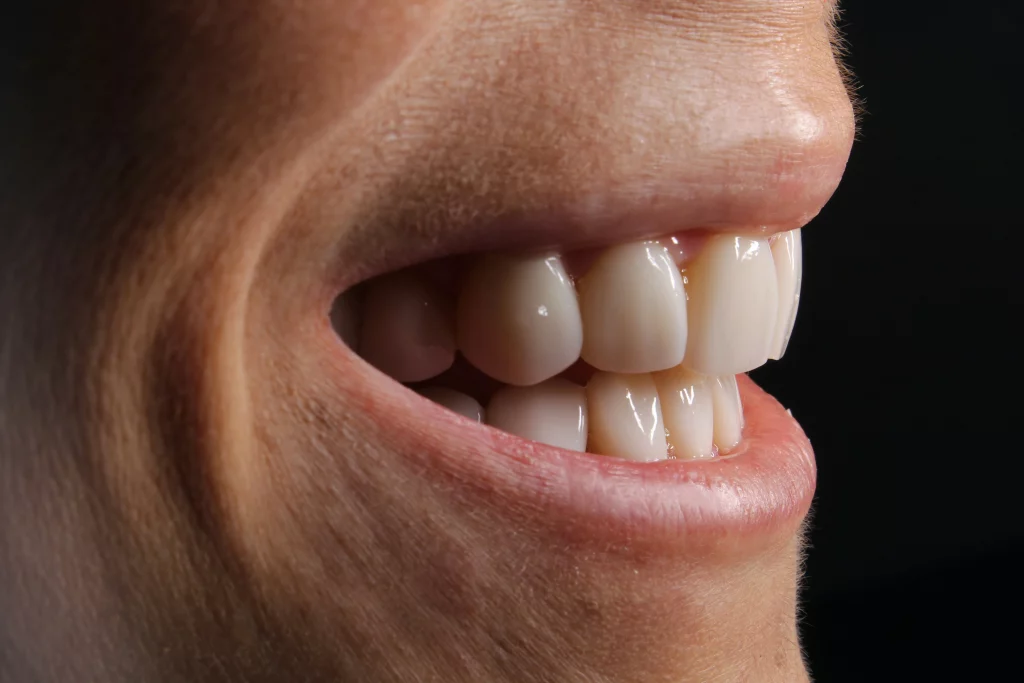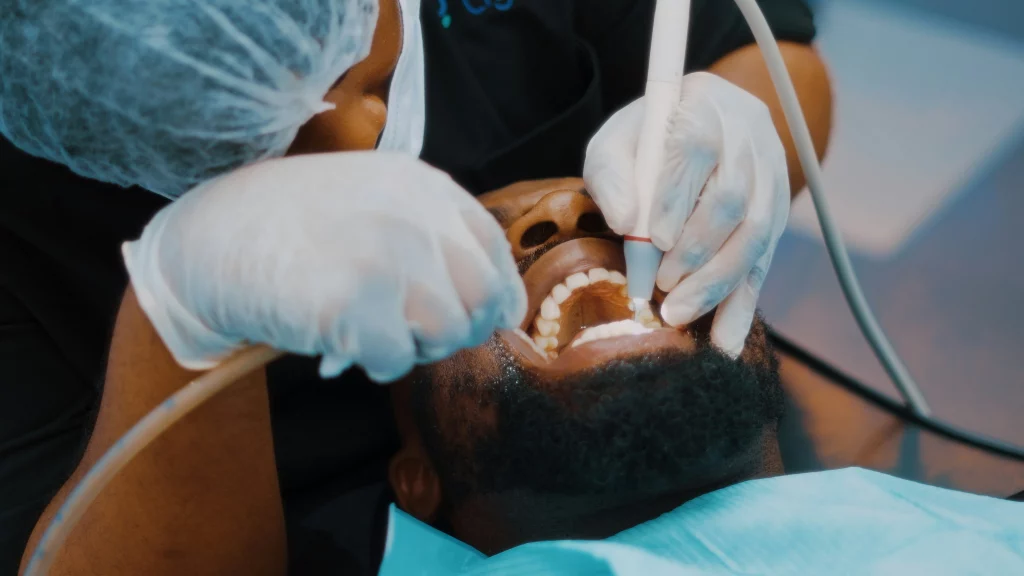Teeth whitening and dental implants are both widely utilized for smile enhancement, yet their interaction is not always straightforward. Teeth whitening methods are effective on natural teeth, resulting in a noticeably brighter appearance; however, the same cannot be said for implants, crowns, or similar restorations, as these materials do not respond to whitening agents. This distinction makes careful planning imperative for patients considering both procedures.
For individuals with existing implants, teeth whitening will only alter the shade of their natural teeth, possibly resulting in a mismatch. Conversely, for those preparing for implants, it is advisable to undergo whitening beforehand so that the color of the restorations can be matched appropriately to the newly whitened teeth. Combining teeth whitening with dental implants requires thoughtful sequencing to achieve a harmonious and natural-looking outcome. This blog will further explore optimal approaches to integrating these treatments and achieving the most aesthetically pleasing results.
Teeth Whitening and Dental Implants Explained

Teeth whitening and dental implants are two of the most requested cosmetic dental treatments, but combining them requires thoughtful planning. Many patients don’t realize that while natural teeth respond well to whitening treatments, dental implants do not. This difference can lead to mismatched shades if care isn’t taken to align both treatments for aesthetic harmony.
Dental implants are designed to last for decades, and their ceramic crowns are color-matched to your existing teeth at the time they’re placed. Once the crown is fabricated and installed, its color is set. Teeth whitening treatments won’t alter its appearance. That’s why timing is everything if you’re considering both a brighter smile and tooth replacement.
Can You Whiten Dental Implants?
No, dental implant crowns, which are typically crafted from porcelain or zirconia, do not respond to bleaching agents in the way natural enamel does. Whitening products function by penetrating the porous structure of natural teeth and oxidizing internal stains—a process that cannot occur in the non-porous, synthetic materials used for crowns. Consequently, regardless of the strength or duration of whitening treatment, the color of a dental crown will not change. If a crown no longer matches adjacent teeth following whitening, replacement may be necessary to achieve a uniform appearance. Your dentist can advise on the best course of action.
Differences Between Natural Teeth and Implant Crowns
It’s important to recognize the distinct structural and material differences between natural teeth and dental implants. Natural teeth are composed of enamel and dentin—layered tissues that are both susceptible to staining from substances like coffee, wine, or tobacco. These tissues also respond to whitening treatments, allowing for noticeable color changes.
By contrast, implant crowns are fabricated with a fixed shade, chosen to match your surrounding teeth at the time of placement. While their resistance to staining is advantageous, it also means that they remain unchanged by subsequent whitening procedures. As a result, if you whiten your natural teeth after receiving an implant, the implant crown may no longer blend seamlessly and could appear darker than your newly whitened teeth.
Common Misconceptions About Whitening Implants
Many people assume all teeth-like materials can be whitened, but this leads to disappointment when their implant crown doesn’t lighten along with the rest of their teeth. Over-the-counter products often give the impression they’ll whiten any smile, but few disclose that restorations like crowns, bridges, or veneers will not respond.
Another misconception is that professional whitening might “clean” or brighten the crown. While your dental hygienist can polish the surface and remove external buildup, the base color will remain unchanged. The best solution for color mismatches is crown replacement with a new shade that complements your natural teeth.
Whitening Options Before Dental Implant Placement

If you’re considering a dental implant, it’s actually wise to whiten your natural teeth before the procedure. Here’s why: the crowns used for implants don’t respond to whitening agents at all. So, if you brighten your natural teeth beforehand, your dentist can match the implant crown to that lighter shade. This ensures a more harmonious and authentic-looking smile—no mismatched colors, just an even appearance across all your teeth.
Why Whitening Is Best Done Before Implants
The most effective way to achieve a seamless look is to whiten your teeth before your implant procedure. This allows your dentist to match the crown color to your newly whitened teeth ensuring consistency across your entire smile. Even if your implant surgery is a few months out, it’s a good idea to discuss whitening early in your treatment plan. Since crowns are permanent and do not change color, getting your natural teeth to your ideal shade first is the best strategy.
Matching Implant Crowns to Whitened Teeth
Once your whitening is complete and your teeth have had time to stabilize in shade (usually 1–2 weeks post-treatment), your dentist will use shade-matching tools to select the color of your new crown. This process is done with careful lighting and sometimes photography to ensure your crown blends in as naturally as possible. If you skip the whitening step before implant placement, it’s possible to go back later and whiten the natural teeth, but the implant crown may appear dull or yellow in contrast.
Ideal Timing for Cosmetic Whitening and Implants
The sequence of procedures here is actually quite important. First, teeth whitening should be performed, ideally under professional supervision, to ensure even and predictable results. It’s advisable to wait one to two weeks afterward, allowing the color to stabilize fully. Once the shade has settled, dental implant placement and the necessary healing period can proceed. After successful osseointegration, the final crown should be fabricated to match the newly established tooth color. Following this timeline helps optimize both function and aesthetics, resulting in a more harmonious and natural-looking outcome.
Best Teeth Whitening Methods for Implant Patients

It’s important to note that implant crowns do not respond to whitening treatments. With this in mind, patients are better equipped to make choices that optimize both the appearance and durability of their dental work. Whitening your natural teeth prior to the placement of an implant crown ensures a closer color match and a more harmonious overall smile. Attempting to whiten after the crown has been placed often results in noticeable color discrepancies between the crown and your natural teeth. By coordinating with your dental provider and planning ahead, you can achieve a more aesthetically pleasing and balanced outcome. This proactive approach helps maintain the longevity and visual appeal of your dental restorations.
Professional Whitening vs. At-Home Kits
Professional whitening administered in-office delivers faster, safer, and more consistent results than over-the-counter kits. Dentists use stronger bleaching agents and provide customized trays, which reduce the risk of gum irritation or enamel damage. This is especially important for patients with implants, who need to protect surrounding tissues and maintain the integrity of their restorations. If you’ve already had implants placed, your provider will work around them and advise on maintaining uniformity.
Whitening Strips and Implant Safety
Whitening strips aren’t harmful to dental implants, but they also won’t help the implant blend with whitened teeth. They can also lead to uneven results, especially when used without professional guidance. If your goal is to whiten teeth while preserving the look of your implant, it’s wise to speak with your dentist first. They can recommend whether strips, gels, or professional whitening would be safest and most effective for your case.
Whitening Sensitive Teeth with Implants Present
Some people experience sensitivity during whitening especially if they’ve had past dental work. While implants themselves do not cause sensitivity, the surrounding natural teeth may. To manage this, your dentist may suggest using a desensitizing toothpaste leading up to treatment or opting for slower, take-home whitening systems. These can be gentler on enamel and easier to control in terms of strength and exposure time.
Long-Term Aesthetics of Teeth and Implants
Sustaining an attractive smile requires a thoughtful, long-term approach. While implant crowns are fabricated from materials that resist staining, natural teeth remain susceptible to discoloration from everyday factors such as certain foods, beverages, and lifestyle habits. As time progresses, this disparity may result in a visible color mismatch between the implant and adjacent teeth. Consistent professional dental cleanings, periodic whitening procedures, and diligent oral hygiene practices are essential in preserving a uniform, radiant appearance. By proactively maintaining both natural teeth and dental restorations, individuals can achieve enduring aesthetic results and a smile that continues to inspire confidence.
How to Keep Your Smile Consistent Over Time
If you’ve taken the step to match your crown to your whitened teeth, maintaining that aesthetic becomes essential. This typically involves scheduling regular professional cleanings with your dental provider. At-home whitening touch-ups may also be advisable, following professional guidance. It’s wise to minimize consumption of foods and beverages known to cause staining—think coffee, red wine, or deeply pigmented sauces. Rinsing your mouth with water after meals can help reduce the impact of staining agents. Ultimately, a steady commitment to oral hygiene and occasional whitening treatments will support a consistently bright appearance, even as natural teeth undergo gradual changes over time.
Tips for Maintaining Whitening Results
To minimize staining, consider using a straw when consuming beverages such as iced coffee or tea. Additionally, incorporate a non-abrasive whitening toothpaste into your oral care routine once or twice weekly. It is advisable to reduce or eliminate smoking, as it is a significant contributor to discoloration. Schedule professional touch-ups with your dentist annually or biannually, as recommended. Consistently following these guidelines helps maintain color consistency between your natural teeth and any crowns, reducing the likelihood of noticeable differences over time.
When to Replace Implant Crowns for Color Matching
If you’ve undergone teeth whitening after your implant crown was placed and there’s now an obvious mismatch in color, replacing the crown is often advisable. While contemporary crowns are engineered to last for a decade or longer, aesthetic considerations can justify earlier replacement. Your dentist will assess the current crown’s condition and function to determine if a new restoration could provide a more harmonious appearance. Opting for a replacement also presents an opportunity to take advantage of advancements in crown materials, which can enhance the natural look of your smile.
Frequently Asked Questions (FAQs)
1. Can dental implants be whitened like natural teeth?
No, dental implants cannot be whitened, as the crown material, usually porcelain or ceramic, does not respond to bleaching agents. Unlike natural teeth, implants are color-stable and retain their original shade over time. However, you can still whiten the surrounding natural teeth to brighten your overall smile. If the implant crown no longer matches your whitened teeth, it can be replaced to better align with your new shade. This option is especially useful if aesthetics are a top priority. Planning ahead with your dentist ensures the best results and a more natural, cohesive smile.
2. Should I whiten my teeth before or after getting implants?
Whitening before implants is strongly recommended for the most natural-looking results. Once the implant crown is placed, its color is permanent and cannot be altered by whitening treatments. If you whiten your natural teeth afterward, the crown may appear darker or mismatched in comparison. By whitening first, you give your dentist the opportunity to match the crown precisely to your desired tooth shade. This ensures a seamless, balanced smile that looks both bright and uniform. Planning ahead helps avoid unnecessary replacements and preserves the beauty of your restoration.
3. What’s the best whitening method if I have implants?
Professional whitening under the guidance of your dentist is the safest and most effective option especially if you have or are planning to get dental implants. It ensures even, consistent results while protecting sensitive teeth, gum tissue, and any existing restorations. Dentists can customize the treatment to your needs and monitor for any signs of irritation or complications. While over-the-counter products may provide mild improvements, their results are less predictable and may not address your specific concerns. For the best outcome and long-term dental health, professional supervision is strongly recommended.
4. Will whitening make my implant crown look mismatched?
Yes, whitening your natural teeth after getting a dental implant can create a noticeable mismatch in color. If the crown was originally matched to your natural tooth shade before whitening, it will remain the same while your other teeth become lighter. This contrast can make the crown appear darker or out of place. In such cases, you may want to consider replacing the crown to better match your newly whitened smile. Discussing your whitening goals with your dentist beforehand can help avoid this issue and ensure a more uniform, aesthetically pleasing result. Planning ahead is key to a cohesive, confident smile.
5. Do I need to replace my crown if my teeth get whiter?
Not necessarily, but if the color difference between your crown and natural teeth is noticeable and bothersome, replacing the crown is definitely an option. Implant crowns are durable and long-lasting, so they don’t need to be replaced unless there’s a functional or aesthetic reason. If your whitened teeth make the crown appear mismatched, your dentist can assess whether your current crown still fits properly and functions well. If so, replacing just the crown for a better color match may be a simple solution. This approach can help restore balance to your smile without compromising the integrity of your implant.
Ready to brighten your smile with confidence? Planning teeth whitening and dental implants together takes more than just picking the right products, it takes a dentist who understands how to coordinate both treatments seamlessly. Whether you’re preparing for your first implant or looking to refresh your smile after whitening, we’re here to guide you through every step.
At Graham Park Dental, we combine aesthetic vision with restorative expertise to create smiles that look natural, healthy, and balanced. Book your consultation today to discuss your goals, review your options, and build a treatment plan tailored to you. We’re here to help you love your smile for life.


